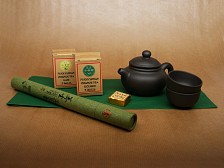
|
Gift set - Chinese Tea
|
Indulge in the Chinese tea ceremony of Gong Fu, with our beautiful Chinese tea gift set. The style of Gong Fu is centred around the idea of brewing and serving tea as an art and connecting with the mind and body. It is a symbolic ritual that involves brewing and serving tea, and is a way to show respect, celebrate life, and find peace. |
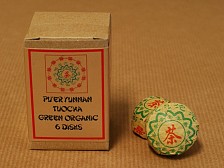
|
Menghai Ripe Puer
|
Menghai Ripe Tuocha Puer, produced in Xishuangbanna, Linyia is highly prized and popular fermented tea from China. It is renowned both for its purported health benefits and because it is aged, in some cases for many decades to develop it’s depth of flavour. |
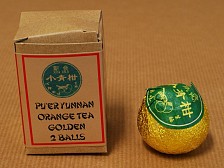
|
Puer Tea in Clementine
|
Orange Pu'er is a specific type of tea, combining the refreshing fragrance of "Xinhui" citrus fruit with the aged flavour of palace ripened Pu-er tea. Produced in Jiangmen City in the Guandong provence in China. Clementines are hollowed out and filled with Pu'er tea, then aged. The Pu'er tea leaves thus obtained when steeped, have a zesty orange smell and the tea is smooth and malty with hints of orange. |
2 Forms |
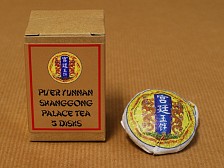
|
Shanggung Royal Palace Puer
|
Shanggung Royal Palace Puer is a highly prized and popular fermented tea produced in the Yunnan province of China. It is renowned both for its purported health benefits and because it is aged, in some cases for many decades to develop it’s depth of flavour. |
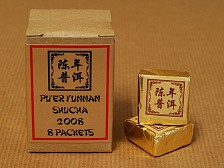
|
Shucha Puer from 2008
|
Shucha Puer from 2008 in small bricks. A highly prized and popular fermented tea produced in the Yunnan province of China. It is renowned both for its purported health benefits and because it is aged, in some cases for many decades to develop it’s depth of flavour. |
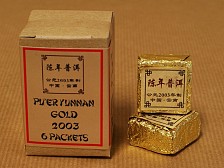
|
Yunnan Puer Gold from 2003
|
Yunnan Pu'er Gold from 2003, in a little gold-wrapped block. Pu’er or Pu'er tea (pronounced ‘poo-air’) is a highly prized and popular fermented tea produced in the Yunnan province of China. It is renowned both for its purported health benefits and because it is aged, in some cases for many decades to develop its depth of flavour. |
2 Forms |